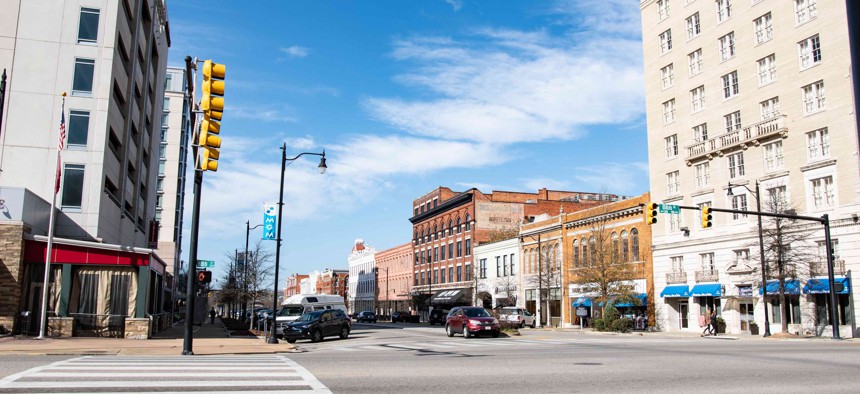A $4.5B Pool of Economic Recovery Funds States, Localities Can Tap Into

A view of Commerce Street in Montgomery, Alabama. The Montgomery area is one of the places that will receive EDA grants under the CARES Act. iStock.com/Jacqueline Nix

Connecting state and local government leaders
The U.S. Economic Development Administration received an influx of Covid relief dollars over the past year that is more than 10 times the size of its usual budget. That money is now flowing as grants.
The U.S. Economic Development Administration is flush with cash these days. In fiscal 2020, the federal grant-maker had a budget of about $330 million. Now, two rounds of coronavirus relief passed by Congress have pumped more than $4 billion dollars its way, money that is destined for grant recipients that include state and local governments and certain nonprofit groups.
“It’s been both a challenge and a tremendous opportunity for the agency,” Dennis Alvord, EDA’s deputy assistant secretary for economic development and chief operating officer, said of the funding surge during an interview with Route Fifty last week.
“We definitely have had to think differently about our business model and how we undertake our grant-making mission to aid the nation’s most economically distressed communities,” he added.
Amid the influx of funding, the agency last month revised its investment priorities to include “equity” for the first time. There were other updates as well, like adding references for—and thereby giving greater consideration to—“coal and power plant communities,” “tech-based economic development” and environmental sustainability.
The amended investment priorities matter for grantees because they provide a framework for the types of projects and programs EDA is looking for when it awards competitive grants. In other words, proposals that mesh with the priorities have a better shot at funding.
The changes also mean EDA will put more of an emphasis on outreach and assistance for communities that may have missed out on past funding opportunities because they didn’t know about them, or that lack the capacity to go after funding, according to Alvord.
“What we'll be looking at is how communities—when they are applying for EDA assistance—is how they articulate how their particular grant proposal is going to further the objectives outlined in one or more of the new investment priorities,” he said
He also said he'd encourage grant applicants to talk about how their proposals will help to “advance more equitable outcomes” for people living in places like tribal lands, underserved rural areas, or counties or pockets of cities that have persistently high levels of poverty.
Created in 1965, EDA bills itself as the only federal agency focused exclusively on economic development. In recent years, the agency has also taken on more of a role in assisting with economic recovery efforts after natural disasters.
The March coronavirus relief legislation known as the American Rescue Plan included a giant pool of roughly $350 billion in direct state, city and county relief funding that is bound for thousands of jurisdictions all across the country. That money, managed by the Treasury Department, continues to draw heavy attention from the state and local government community.
But $3 billion that EDA is now overseeing is an example of another funding stream available through that law that communities can potentially tap into. Of that total, Congress specifically set aside $750 million, or 25%, for places that were negatively affected by drops that the coronavirus has caused in the tourism, travel and outdoor recreation sectors.
This money comes atop of $1.5 billion the agency received from the CARES Act, the pandemic relief measure Congress passed last year.
‘Diverse Mix’ of Proposals So Far
EDA is still working on funding opportunity notices that will provide more detailed guidelines for American Rescue Plan grants. But awards the agency provided with CARES Act dollars, which have gone toward a variety of projects, give a sense of how future grants might be used.
In the final days of April For example, EDA awarded $3.8 million to Salina, Kansas, for drainage and road improvements meant to allow for business expansion and $3 million to the Business Council of Alabama, in Montgomery, to establish a long-term pandemic recovery strategy for businesses, nonprofits and communities.
Alvord said one trend EDA has seen during the pandemic is grant applications for broadband expansion projects, including planning and infrastructure build-outs.
The agency has also run an initiative centered specifically around health and biomedical endeavors and related entrepreneurship. And it has distributed grants to recipient organizations that run revolving loan fund programs that can help businesses gain access to capital—something that became difficult for some of them during the early days of the pandemic.
“We’re really seeing a very diverse mix of program needs that have bubbled up,” Alvord said.
To get the CARES funding distributed quickly, EDA awarded about half of it through a noncompetitive process to grantees it had worked with before, with known track records.
Congress gave EDA authority to beef up its staff to help handle the additional dollars, and the agency has done so. It is also providing its employees with extra training in how to detect waste and fraud and boosting the ranks of its performance and evaluation division to track whether grants are achieving intended outcomes.
Alvord said last week that the funding announcements and notices for the American Rescue Plan money would likely be released in phases over the coming weeks and months, but didn’t provide an exact timeline for that process.
“We’re on the precipice,” he said. “Stay tuned.”
Bill Lucia is a senior editor for Route Fifty and is based in Olympia, Washington.

NEXT STORY: State 529 Education Account Winning American Families’ Pandemic Savings





